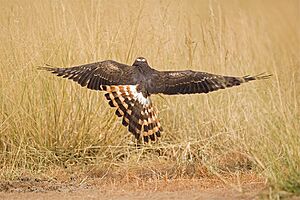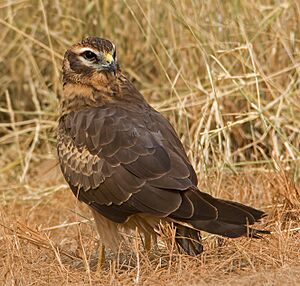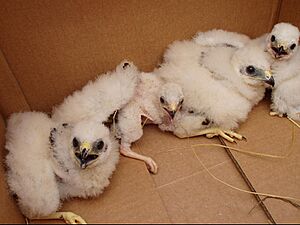Montagu's harrier facts for kids
Quick facts for kids Montagu's harrier |
|
|---|---|
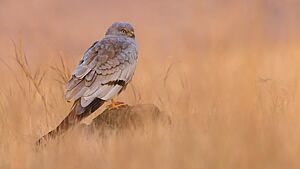 |
|
| Male individual from a grassland near Pune, at Bhigwan | |
| Conservation status | |
| Scientific classification | |
| Genus: |
Circus
|
| Species: |
pygargus
|
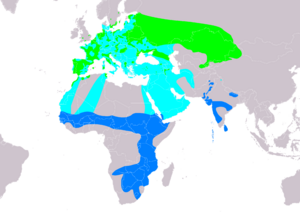 |
|
| Range of C. pygargus Breeding Passage Non-breeding | |
| Synonyms | |
|
Falco pygargus Linnaeus, 1758 |
|
The Montagu's harrier (Circus pygargus) is a type of bird of prey that travels long distances. It belongs to the harrier family. This bird is named after George Montagu, a British expert in nature.
Contents
About the Montagu's Harrier
Montagu's harriers are medium-sized birds of prey. They are known for their graceful flight. These birds hunt by flying low over open areas. They are found in many parts of Europe, Asia, and Africa.
How Scientists Name Them
The Montagu's harrier was first officially described in 1758. This was done by a Swedish scientist named Carl Linnaeus. He gave it the scientific name Falco pygargus. Later, it was moved to the Circus group of birds. The name Circus comes from an old Greek word. It means "circle" and refers to how these birds fly in circles. The word pygargus means "shining white rump." This describes the white patch on the bird's back.
How to Identify a Montagu's Harrier
It's easy to tell male and female Montagu's harriers apart. They have different colored feathers.
Male and Female Plumage
Adult male harriers are mostly light grey. They have black tips on their wings. They also have black bands on their wing feathers. You might see rusty streaks on their bellies.
Adult females look similar to other harrier species. Their undersides are pale yellow-brown. They have stripes on their belly. Their upper parts are dark brown. They have a white patch on their lower back, called the rump.
Young Birds
Young harriers look a lot like the females. However, their belly and underwing feathers are not spotted. Instead, they are a uniform reddish-brown color.
Melanistic Birds
Sometimes, you might see a very dark Montagu's harrier. This is called a melanistic form. The male in this form is much darker than usual. It has a black head and brownish-black upper parts. The female is entirely chocolate brown.
How They Fly
Montagu's harriers fly in a very elegant way. Their wingbeats are powerful but light. This makes them look like they are floating easily in the air. They often hold their wings in a "V" shape while flying. They fly low to the ground when hunting.
Size and Weight
Montagu's harriers might look big because of their wide wings. But they are actually quite light. Female harriers are larger than males. This is because females need to produce eggs.
- Wingspan: 97 to 115 centimeters (38 to 45 inches)
- Length: 43 to 47 centimeters (17 to 18.5 inches)
- Average Weight:
- Male: 265 grams (9.3 ounces)
- Female: 345 grams (12.2 ounces)
Similar Birds
Montagu's harriers can be confused with other harrier species. These include the hen harrier and the pallid harrier. Male Montagu's harriers are easier to tell apart. Their feathers are darker and more patterned.
However, telling females and young birds apart is harder. Montagu's harriers usually look thinner in flight. They have longer tails and narrower wings. Their flight is also more graceful. The hardest to tell apart are female pallid and Montagu's harriers. Pallid harriers have a pale collar around their neck. Montagu's harriers do not have this collar.
Where They Live
Montagu's harriers live in areas with mild climates. They can also be found in Mediterranean and colder northern regions. They prefer low-lying areas like river valleys and plains. They also live near lakes and the sea.
They can nest in wetlands, but these are often drier. They also use heaths, sand dunes, and moors. Sometimes, they live in steppe grasslands. They can even adapt to areas with shrubs or young pine trees.
Nesting in Farmlands
If there are no other good places, these harriers will nest in farm fields. They especially like grasslands and grain crops like wheat and barley. This makes them vulnerable to farm machinery. In some parts of Europe, up to 70% of these birds nest in farmed areas.
For nesting, they need a large open space. The plants on the ground need to be tall enough to hide the nest. They also like to have posts or small trees nearby. These spots are used for resting and watching over their nesting area. When hunting, they prefer areas with low plants. This makes it easier to see their prey. They usually avoid busy human areas.
What They Eat and How They Hunt
Montagu's harriers mainly eat small rodents and small birds. They also eat bird eggs, snakes, and large insects. Their diet changes depending on what food is available. In northern areas, they might eat more ground squirrels. In southern Europe, they eat more small reptiles and large insects.
They hunt by flying low and slowly. They fly along fixed paths, about 30 kilometers per hour (18 mph). Their light and agile flight helps them catch quick prey. They often follow the edges of plants to surprise their food. They swoop down to catch prey. They can also chase fast-running animals or flying birds for a short distance.
Food for the Family
During the breeding season, the male brings food to the female. Later, he brings food for the young birds too. He might bring food 5 to 6 times a day when the female is sitting on eggs. This increases to 7 to 10 times a day after the chicks hatch.
The male hunts far from the nest, up to 12 kilometers (7.5 miles) away. The female hunts closer to the nest, about 1 kilometer (0.6 miles) away. She only starts hunting after the young have hatched. The male often passes food to the female in the air. He drops the prey, and she catches it while flying below him.
Where They Are Found and Their Numbers
Montagu's harriers are found across most of Europe and parts of Asia. They are also found in northern Africa, mainly in Morocco. In Great Britain, they are rare and mostly found in southern England. They are not common in many areas. However, they have strong populations in France, Spain, Russia, Belarus, and Poland.
Their breeding sites can change often. Sometimes, they nest in new places. But there are clear signs that their numbers are decreasing in some areas.
Population Trends
It's estimated that there are 35,000 to 50,000 pairs in western Europe and Asia. The total number of Montagu's harriers in the world is not fully known. It could be between 150,000 and 200,000 birds. This is because many live in Russia and former Soviet countries where they haven't been counted.
In the early 1900s, their numbers actually grew. This was unusual because other birds of prey were decreasing. But from the 1940s onwards, their population dropped quickly. This was due to several reasons:
- Pesticides: The widespread use of farm chemicals like DDT harmed the harriers. It also reduced the number of insects they eat.
- Farming Changes: Modern farming methods are more intense. Crops grow faster. This means that nests in farmlands are often destroyed by harvesting machines before the young birds can fly.
Despite these problems, some local populations have increased. This shows that if they have good habitats and enough food, they can still thrive.
Life Cycle and Reproduction
Montagu's harriers can live alone or in groups. This happens both during breeding and in winter. Breeding pairs might form loose groups, called colonies. There can be up to 30 nests in one area. Sometimes, nests are as close as 10 meters (33 feet) apart.
Nesting in groups helps them defend against predators. The parents only defend a small area around their nest. But in a colony, the whole group might work together to chase away predators. They attack large birds of prey, crows, and foxes.
Nesting and Young
Reproduction starts when the male and female return to their nesting site. They perform special "sky-dances" to attract each other. Both sexes display, but the male's dances are more impressive.
Montagu's harriers usually breed for the first time when they are two or three years old. They likely mate with the same partner each year. The female builds the nest. It's a simple nest made of grass. It's always built in tall plants and used for only one season.
The female lays 3 to 5 eggs. She sits on them for 27 to 40 days. The young birds leave the nest after 28 to 42 days. They become independent about two weeks later. Sometimes, a male harrier might have more than one female partner. This means he has to feed two families at once.
Their Long Journey: Migration
Montagu's harriers are long-distance migrants. Birds from Europe and Asia spend their winter in Africa, south of the Sahara desert. Those from eastern Asia travel to India.
In Europe, they start moving in early August. Most have left by mid-October. They fly across the Mediterranean Sea at many different points. Western birds don't go further south than the Gulf of Guinea. But some eastern birds travel all the way to South Africa. In Africa, they mostly eat insects and birds. They might even follow swarms of locusts.
They return north in April. Most birds have arrived by May. However, some young birds might stay in their winter homes for their first summer.
Protecting Montagu's Harriers
In western Europe, many Montagu's harriers nest in farm fields. This makes them very vulnerable. Their nests can be destroyed when farmers harvest their crops. Because of this, protecting their nests is very important.
Bird protection groups work with landowners to help. When a nest is found in a field, it can be protected. Sometimes, the nest is moved to a safer area. Other times, a protected space is created around the nest. This area is not harvested. In France and Spain, these efforts save about 60% of the young birds.
Images for kids



